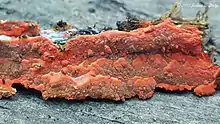| Phlebia coccineofulva | |
|---|---|
 | |
| Scientific classification | |
| Domain: | Eukaryota |
| Kingdom: | Fungi |
| Division: | Basidiomycota |
| Class: | Agaricomycetes |
| Order: | Polyporales |
| Family: | Meruliaceae |
| Genus: | Phlebia |
| Species: | P. coccineofulva |
| Binomial name | |
| Phlebia coccineofulva Schwein. (1832) | |
| Synonyms[1] | |
| |
Phlebia coccineofulva, commonly known as the scarlet waxcrust, is a species of crust fungus in the family Meruliaceae. It was described as a new species by Lewis David de Schweinitz in 1832.[2] The fungus is found in North America, continental Europe, and northern Asia, where it grows as a saprophyte on decaying stumps and woody forest debris.[3]
References
- ↑ "GSD Species Synonymy: Phlebia coccineofulva Schwein". Species Fungorum. Kew Mycology. Retrieved 2017-08-18.
- ↑ Schweinitz, L.D. von (1832). "Synopsis fungorum in America boreali media degentium". Transactions of the American Philosophical Society (in Latin). 4 (2): 165.
- ↑ Roberts, Peter; Evans, Shelley (2011). The Book of Fungi. Chicago, Illinois: University of Chicago Press. p. 429. ISBN 978-0-226-72117-0.
This article is issued from Wikipedia. The text is licensed under Creative Commons - Attribution - Sharealike. Additional terms may apply for the media files.